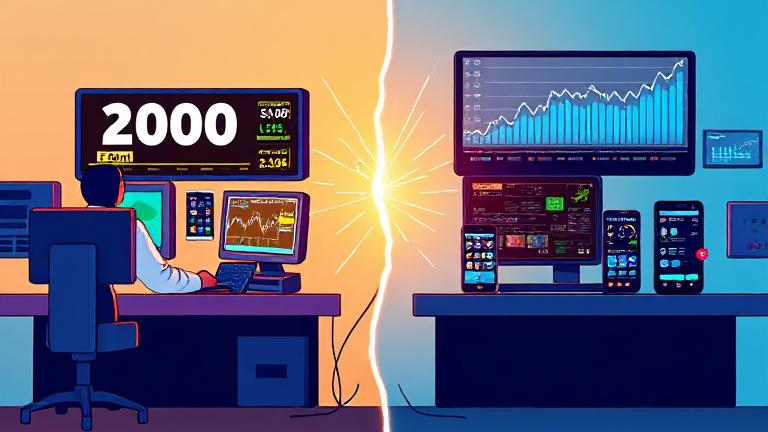Technology Stocks Overvalued? 10 Shocking Lessons History Tells Us

But the question persists: Are technology stocks overvalued in the fast-moving world where we live, or do they represent the real cost of progress and innovation? As leading technology companies — Apple, Amazon, Microsoft, new giants like NVIDIA — keep smashing through heights of valuation, a sense of déjà vu settles over many investors. The question “Are technology stocks overvalued?” is once more grabbing headlines, similar to previous market bubbles that were followed by sharp corrections.
Against a backdrop of rising interest rates, economic uncertainty and elevated price-to-earnings ratios, concerns about overvaluation are difficult to overlook. However, tech has remained the dominant global market force, fueled by AI, cloud computing and digital transformation. So, are we in a bubble — or just adjusting to a tech-centric world?
To find out, we have to turn back. From the dot-com crash to the 2020s tech surge, history can provide important perspectives on market behavior, investor psychology and the perils of hype. This piece discusses what we can learn from the past about the future of tech investing.
Table of Contents
The 2025 Debate – Are Technology Stocks Overvalued?

The tech stock backlash has reached new heights as we drift deeper into 2025. In recent years, the tech sector has boomed due to advancements in AI, (what ai can do today) cloud computing and other innovative technologies. And companies such as Apple, Google and Tesla have achieved market caps that many consider unsustainable. This is combined with the increasing cost of capital due to rising interest rates, making it tough for tech companies to justify their sky-high valuations. Investors are asking whether these prices are an accurate prediction of future earnings potential, or are simply hype.
The tech industry has seen cycles of boom and bust in the past, like the dot-com crash of the early 2000s. Fast forward to 2025 and history may repeat itself, with potentially overvalued tech stocks prepping us for a market pullback. For savvy investors, discerning between true innovation-led growth and frothy prices is key to successfully navigating this volatile sector.
A Historical Overview: Tech Bubbles Through the Decades

he history of tech bubbles is marked by cycles of excessive optimism, followed by steep crashes. Perhaps the best example of this is during the dot-com bubble of the late 1990s and early 2000s, when the internet was the hot new thing. Tech startups were riding high on inflated valuations and investor dollars were flowing into companies without much knowledge of how they would turn a profits. The bubble burst in 2000, creating billions of dollars in losses for investors and showing the dangers of investing based on fluff and not sound fundamentals.
By the mid-2000s, the tech sector revived, but the 2008 financial crisis revealed weaknesses in over-levered tech investments. Such a collapse, however, was not the end of the road for innovative companies like Apple or Google, being formed even as demand slumped, and sowing the seeds for subsequent booms.
The new rise in tech stocks, boosting by AI, cloud computing and electric vehicles, has sparked fears of another potential bubble. With valuations skyrocketing, some analysts question whether today’s market will look to future observers like previous tech crashes — or whether the sector is truly changing the economy.
Dot-Com Bubble vs. Today’s Market: What’s Changed?

The late 1990s and early 2000s saw the Dot-Com Bubble, which was characterized by inflated valuations of internet-based companies that needed nothing more than a business idea and a website. Investors, convinced that the internet was going to transform everything, lavished billions on startups with no proven business model or any clearly defined route to profitability. The dotcom bubble burst in 2000, causing significant losses, with many companies going under and investor wealth disappearing. The event illustrated some of the dangers of speculative investing in tech without regard for fundamental financial health.
The current tech market bears some resemblance to this, with companies in sectors like artificial intelligence, cloud computing and electric vehicles commanding sky-high valuations. But there is an important distinction: Today’s tech giants are mature and profitable. Companies such as Apple, Amazon, and Microsoft have solid business models, generate enormous revenues, and command significant shares of their respective markets. The previous concerns around tech stocks being overvalued still loom, but with much of today’s market focusing on real innovations and long term-growth potential (while risks in a constantly evolving landscape do remain).
Major Drivers of 2025 Tech Valuations
Artificial Intelligence (AI)
In 2025, the tech sector is growing thanks to multiple factors — the most notable of which is Artificial Intelligence (AI). The rapid advancements in AI are disrupting industries ranging from healthcare to finance, leading to an unprecedented demand for AI-based solutions. The technology has already reshaped global economies and companies pouring investments into AI, including OpenAI, Google and Microsoft have been rewarded with soaring valuations. The boom in interest also raises alarm bells: with AI stocks priced off of future sales forecasts, not current profits, technology stocks may be overpriced.
Semiconductor Boom
Semiconductor Boom — Another Key Driver The demand for advanced semiconductors is expanding as AI, cloud computing and electric vehicles take off. NVIDIA, AMD, and others are profiting from this demand, leading stock prices to all time highs. In this sense, the semiconductor industry plays a key role in the global tech ecosystem, albeit its growth has been rapid, spurring speculative investments in the sector, leading to fears of overvaluation.
Big Tech Dominance
Lastly, there is still the formidable force of Big Tech Dominance. The sectors of the market that do the majority of the work, such as giants like Apple, Amazon and Microsoft, are not only more dominant in the market, they are dominating investor focus, and their valuations often move well past their fundamentals, forcing investors to question whether their stocks are hot but also at least somewhat overvalued or still reasonably priced.
Warning Signs: Red Flags That Tech Stocks May Be Overvalued

All of this raises the question of when tech stocks are overvalued and how investors can spot these stocks so they can alter the way they invest in tech when price valuations are out of their comfort zone. A high price-to-earnings (P/E) ratio is one red flag. If a tech company’s P/E ratio is much higher than the industry average, it could suggest that the stock is priced for future growth that won’t happen. Investors sometimes defend high P/E ratios with the argument that certain companies have strong future growth prospects, but too much valuation indicates speculative purchase rather than concrete fundamental growth prospects.
The other sign is lack of profitability. Most tech startups, especially in AI and cloud, are valued on potential, not earnings today. If a business repeatedly reports losses with no roadmap to profitability, it may be a red flag when stock price continues to climb;
Finally, something that has red flags all over it is rapid changes in market sentiment or continued speculative buying. When excitement about a technology generates irrational buying sprees, it usually signals a market bubble that is ultimately unsustainable and will soon burst.
What the Data Says: Key Metrics to Watch in 2025

Understanding whether technology stocks are overvalued requires careful scrutiny of certain metrics in 2025. Among these, one of the most recent important gauges is the price-to-earnings (P/E) ratio. When a company’s P/E ratio is much higher than their counterparts in the same industry, they may be overvalued unless their growth projections warrant the inflated cost. High P/E ratios can be quite understandable for fast-growing tech companies, but excessive mispricing of equity are seldom justified and tend to reflect excessive speculation rather than solid fundamentals.
One more important metric to monitor is the revenue growth. Revenue growth that is both steady and strong can demonstrate a company’s capacity to capture market share or scale its operations. On the other hand, operating revenue falling or stagnating while share prices are still ballooning can indicate that share price rises are more driven by hype than performance. Free cash flow is also essential for evaluating a company’s financial health, with it representing the business’s ability to reinvest in growth or return value to shareholders, which is crucial for long-term sustainability.
Expert Opinions: Analysts’ Views on Tech Overvaluation

And as the argument around tech stocks being overvalued replays in 2025, analysts are still divided. Others argue that the high valuations are justified by major innovations in artificial intelligence, quantum computing and cloud infrastructure. Companies that dominate these spaces now, they believe, are well-positioned to maintain long-term dominance and the current market reflects that potential future earnings. Analysts who are optimistic on tech also cite strong balance sheets, steady revenue growth and rising global demand as reasons some valuations, even though elevated, are justifiable.
But not all analysts are so optimistic. Many warn that some parts of the tech sector are displaying the classic signs of a bubble — excessive speculation, unsustainable growth rates and price-to-earnings ratios that far exceed historical norms. Though innovations are real, the experts emphasize that investor expectations might be running ahead of actual performance. Some even make comparisons to the dot-com era, issuing warnings that a correction could be around the corner. The consensus? Whereas tech continues to be an outstanding force, selective funding and data-driven analysis are more crucial than ever.
Are We in a Bubble or a Transformation Era?
We are a long way from a bubble, unless it is a bubble in speculation about a technological revolution. The high valuations, your Al an Greenspan peak investor angst, and all the nuttiness of speculative funding in areas like AI and robotics many of the things you saw in past market bubbles. Billion-dollar valuations for many startups with barely any revenue, let alone profit other than data, raise the question of whether such expectations are realistic.
Conversely, the technologies catalyzing these valuations — generative AI, quantum computing, green tech — are genuinely transformative. Unlike during the dot-com boom, today’s tech companies usually have actual products and actual revenue and actual market demand. That could indicate we are entering a new economic phase driven by advanced technologies. It’s possible that while some of the overvalued technology stocks concerns are valid, we’re also just now getting used to a new normal where innovation distorts valuation metrics. The trick is to separate hype from real innovation.
Smart Investing in 2025: How to Navigate Tech Volatility

From the perspective of 2025, successfully navigating the tech market isn’t just about being excited about the next wave of innovation—it’s about if, when, and for how much you’ll buy. Concerned with a bubble in technology stocks, investors will have to cut through the hype. Consider companies with strong balance sheets, growing revenue, great management, and a clear moat covering their business. High valuations aren’t necessarily a warning sign if backed by profitability and long-term potential, but unchecked speculation should be treated carefully.
Diversification is more critical than ever. By spreading their investments across various segments of tech (semiconductors, AI, cybersecurity, cloud computing), they can manage their risk while benefiting from growth. Strategies such as dollar-cost averaging can mitigate the effects of temporary downturns in the market. Separating short-term noise from long-term opportunity is critical. Do not panic and sell during corrections and do not throw money into speculative investments during surges.
At the end, smart investing in 2025 is a balancing act of optimism and information. The tech sector remains one of the most exciting investment frontiers — but success is in discipline, research and a longer-term vision.
Final Thoughts: Learning from the Past, Investing for the Future
The legacy of tech investing is packed with lessons — booms, busts and breakthroughs. The dot-com crash taught us not to chase hype when fundamentals do not exist, and the near transformation of game-changers like Google and Amazon emphasized the rewards of patient capital. In today’s climate, … when many expect technology stocks are overvalued, those lessons are more relevant than ever.” Riding blindly on market trends can be expensive, but savvy, disciplined investing can yield long-term benefits.
Going forward, the technology sector looms large over the global economy — from A.I. and automation to green energy and quantum computing. Not all companies will make it, but the ones that do could lead the market in what will be a massive trend. Through knowledge of history, attention to financial stability and purposeful investing, today’s investors can place themselves on the path to long-term success. In a world where everything is constantly changing, the most intelligent strategy is to keep your ears close to the ground and your head in fundamentals.





